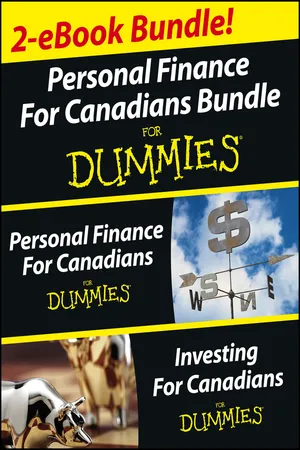
Personal Finance and Investing for Canadians eBook Mega Bundle For Dummies
- English
- ePUB (mobile friendly)
- Available on iOS & Android
Personal Finance and Investing for Canadians eBook Mega Bundle For Dummies
About This Book
Get these two great books in one convenient ebook bundle!
Personal Finance For Canadians For Dummies, Fifth Edition, is a comprehensive road map to financial security. Expert authors Eric Tyson and Tony Martin offer pointers on eliminating debt and reining in spending, along with helpful tips on reducing taxes. Learn how to build wealth to ensure a comfortable retirement and tuition for the kids with a primer on investing. Using up-to-date Canadian examples and references, Personal Finance For Canadians For Dummies, Fifth Edition provides you with the tools you need to take control of your financial life—in good times and bad.
Making your own investment decisions can be intimidating and overwhelming. Investors have a huge array of investment options to choose from, and sorting through the get-rich-quick hype can be exhausting. Investing For Canadians For Dummies provides readers with a clear-headed, honest overview of the investing landscape, helping them to determine what investments are right for their goals.
New for the Third Edition:
- The US sub-prime loan disaster, and how it can be an investing opportunity
- Up-to-date information about new mutual funds and mutual fund alternatives, such as exchange-traded funds
- Perspectives on buying a home in hot real estate markets like Calgary, Montreal, and Halifax
- Valuable advice on the best way to cut start-up costs and minimize tax charges when starting a new business
- New RRSP and RESP information, and advice on what to do with new allowable contribution levels
Frequently asked questions
Information

Table of contents
- Cover
- Contents
- Personal Finance For Canadians For Dummies
- Table of Contents
- Title Page
- Introduction
- Part I: Assessing Your Fitness and Setting Goals
- Part II: Saving More, Spending Less
- Part III: Building Wealth with Wise Investing
- Part IV: Insurance: Protecting What You Have
- Part V: Where to Go for More Help
- Part VI: The Part of Tens
- Investing For Canadians For Dummies
- Table of Contents
- Title Page
- Introduction
- Part I: Investing Fundamentals
- Part II: Stocks, Bonds, and Bay Street
- Part III: Getting Rich with Real Estate
- Part IV: Savouring Small Business
- Part V: Investing Resources
- Part VI: The Part of Tens

